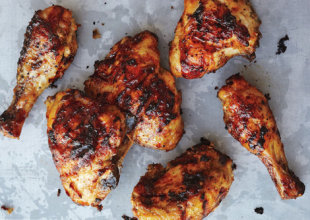 Marcus Nilsson
Marcus Nilsson
by Hunter Lewis and Janet McCracken, Bon Appétit
Even though it's a cookout classic, chicken can be tough to get right on the grill. How do you know when it's done? When should you slather on sauce? What temperature should you cook it at? We consulted the good people of the BA Test Kitchen for solutions to the most common mistakes people make. Read on to crown yourself the king or queen of chicken on barbie.
Not Starting with a Good Bird It should be antibiotic and hormone free at the very least. If the yardstrutter was raised right, then chances are that it will taste good.Even though it's a cookout classic, chicken can be tough to get right on the grill. How do you know when it's done? When should you slather on sauce? What temperature should you cook it at? We consulted the good people of the BA Test Kitchen for solutions to the most common mistakes people make. Read on to crown yourself the king or queen of chicken on barbie.
Forgetting the Seasoning Make sure you sprinkle it with salt and pepper before you throw it on the grill.
Cooking it at Too High a Temperature If you cook the chicken on too hot a grill, the skin will burn before the flesh cooks. Medium-low is the best temperature on a charcoal grill, and medium on a gas grill. This way, you'll crisp the skin and avoid flareups.
Drying Out Skinless, Boneless Chicken Dark meat on the bone is more flavorful and will stay juicier on the grill. But if you're cooking skinless, boneless chicken breasts, cook them on medium for a charcoal grill and medium high for a gas grill. Just watch it carefully and take it off a minute before it's cooked through (the heat will carry-over the cooking as it rests).
Not Keeping an Eye On It You'll notice as you cook that some areas on your grill brown the food faster than others. You have to move the chicken around and turn it until the pieces are cooked evenly. You can tell the cool spots by putting your hand over the grill. It's also ideal to set up for a two-zone fire (on a charcoal grill, push coals over to one side, or on a gas grill, keep one burner turned off) so there's a definite cool area to move the chicken to if the skin is cooking too fast before the flesh is finished.
Not Using a Meat Thermometer
It's the most precise way of telling if the chicken is done. The perfect internal temperature is 165 degrees for dark meat, 160 degrees for white. If you don't have an instant-read thermometer, you can always do a little cut into the middle to check that it's just about opaque in the center. With bone-in pieces, if you insert a small knife to the bone and juices run clear, you are good. If they are still pink, let it go a little longer.
Slathering On the Sauce Too Soon Baste last! Apply any sugary glazes towards the end of cooking. Put it on too soon and it will burn.
Slathering On the Sauce Too Soon Baste last! Apply any sugary glazes towards the end of cooking. Put it on too soon and it will burn.
No comments:
Post a Comment